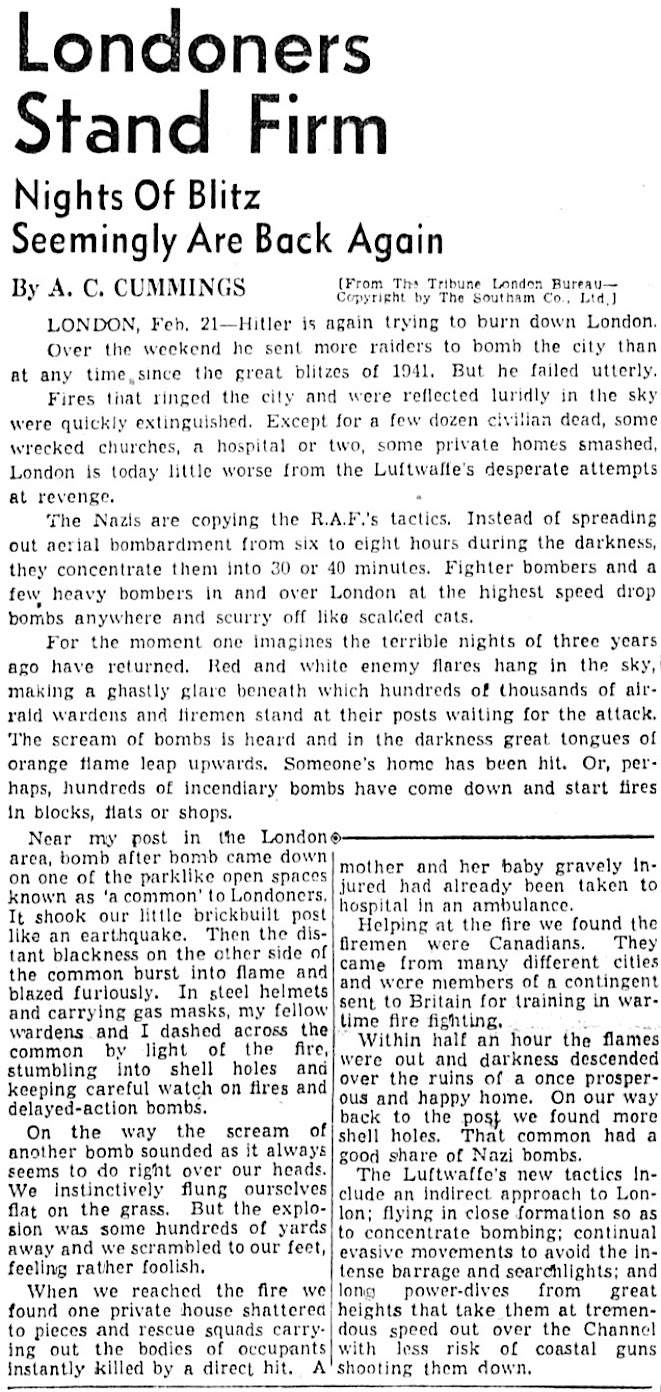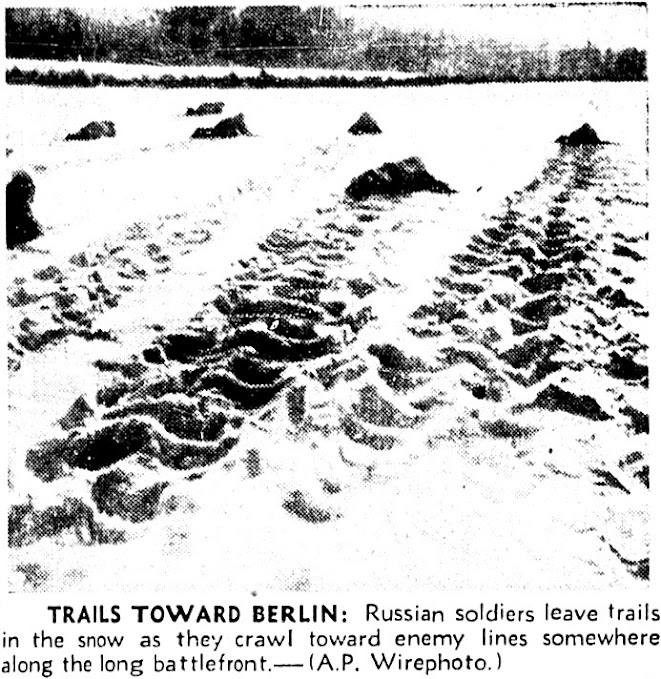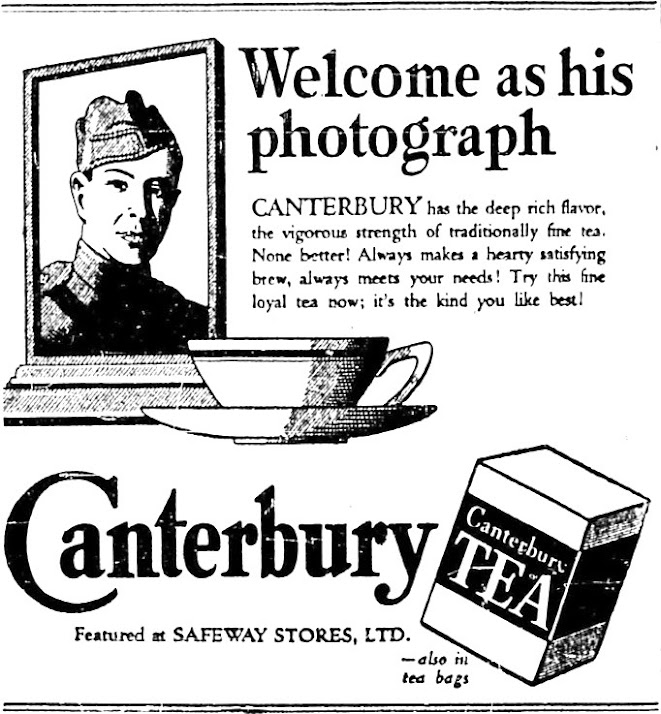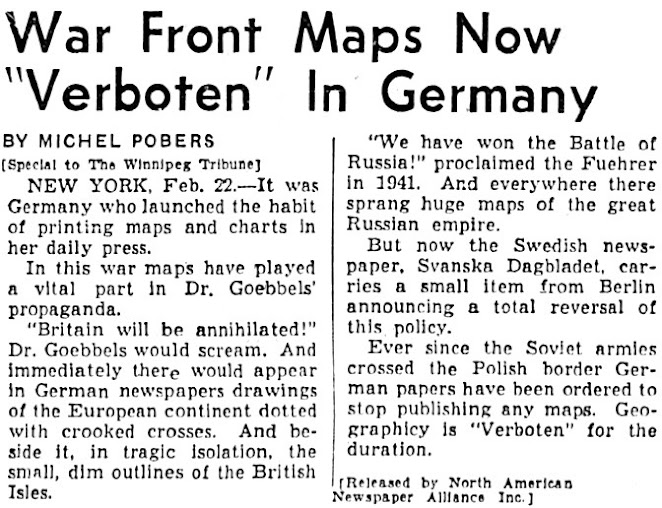News (a Sister Returns!) and Views from The Winnipeg Tribune
February 21 - 22, 1944. No 'Slow News' Days in '44
Allies maraud Italy and Berlin (and more) from the air.
Land battles progress on various fronts as well
Introduction:
This series - related to sharing some information about Canadians returning home after service overseas - is getting lengthy. Eighteen parts at the moment with 3 - 4 more parts to go, i.e., to Feb. 29, 1944. I have focussed to a good degree on the Canadians who were members of RCNVR and Combined Operations, including my father. They were transported to the U.K. in early 1942* and came home in late 1943 (some on a few weeks leave), to shortly thereafter be assigned to other roles or service (e.g., my father and scores of mates went to HMCS Givenchy III at Comox on Vancouver Island in early 1944*) 'til the end of the war or until discharge. Readers will find details re returnees from other services mentioned here as well.
[*their subsequent service in Operations Rutter (Dieppe; cancelled), Jubilee (Dieppe, Aug. 19, 1942), Torch (invasion of N. Africa, beginning Nov. 8, 1942), Husky (Sicily, beginning July 10, 1943) and Baytown (Italy, beginning Sept. 3, 1943), followed by their time at Givenchy III at Comox is primarily the focus of this blog/website]
Though lengthy, this series is nearing its end as well, and will likely lead me to increase the number of entries re HMCS Givenchy III, the home of Canada's only Combined Operations School (C.O.S.) during World War II.
Below, readers will find more details from The Tribune re the war in general with some related materials re Canadians in Combined Ops from various sources:
By February 21, 1944 many observers of Allied progress would estimate that "the tide is turning" or "is well turned" and thoughts of the invasion of Europe would be on many minds. Canadians in Combined Ops who were stationed on Vancouver Island would be becoming more familiar with training associated with invasion tactics as well, though the time and date of and landings in Europe would not be known.
There would be hundreds more "stepping stones to continental invasion", some at the Combined Operations School in Canada:
Photo Credit - The Crows Nest, March 1958, Volume 10, No. 5
One Canadian sailor is still seen on the landing craft (LCM)
Well trained Canadian sailors are hard at work in various roles:
We read below some good news out of Pearl Harbour:
The long, tough slog in Italy - e.g., near Cassino and Anzio - will be in the news for a good deal more time yet:
Berlin was blitzed; London as well:
The photo above depicts a British officer lending a helping hand. One or two members of the 80th Flotilla of Canadian Landing Crafts, during a few hours off during Operation Baytown (the invasion of the toe of the boot beginning Sept. 3, 1943), set up a table in Messina with a few spare medical supplies in order to help some of the needy local citizens.
My father writes the following in memoirs:
In the navy we just acquired things. A tent was set up on the beach after we acquired some salves, soap and gauze to treat the locals who had rashes and cuts, etc. The word spread about the Canadian Marina Hospital and one morning a few days after we opened, two very pregnant ladies appeared. The work of mercy ended, and very quickly I might add, amidst our embarrassment. "Dad, Well Done," page 116
I clipped the following article because my father and mates were on the West Coast at the time of its publication and thoughts of a Pacific War were likely on their minds:
Coincidentally, there was "a rush of population" (in the form of scores of Canadian sailors returned from oversea's service) to a West Coast navy base, and I would think that they might have had some hand in assisting with their own housing situation:
"If you want running water and workin' terlets, git shovellin'."
Some of the overseas crew at HMCS Givenchy III, 1944 - '45
Comox is across a small bay, behind them
Doug "Cactus" Harrison, front left, with other members of RCNVR and
Combined Operations. They trained w commandos, thus the nicknames.
Comox is behind them, across the bay, on the left side of photo
Dad plays a bit of horseshoes between duties and ballgames
New accommodations at HMCS Quadra today, for cadets.
Where were the sailors' barracks in 1944 - '45?
"And if you want a heated barracks, start shovelling!"
Back to the Allied war efforts in Italy:
A story re MIA with a happy ending. Not everyone's mother would have been laughing even by the last paragraph!
The next ad below depicts a happy and skilled sailor. Yup, sailors liked their chocolate. In memoirs my father recalls a break in the action in Malta (he had been shipped there early due to dysentery; August, 1943) before the upcoming invasion of Italy, September 3rd. Chocolate bars were a highlight:
When my friends returned from Sicily in their landing craft, I was waiting for them at the bottom of the cement steps (in Valletta).
Our commanding officer Lt/Comdr Koyl and a few hands disappeared for awhile and when they returned they were weighted down with kit bags of parcels and mail. The blues dis-appeared and quietness settled in as every one of us, in a different posture, chewed on an Oh Henry bar* and read news from home.
The war wasn’t so bad after all. We shared with anyone who hadn’t received a parcel; no one went hungry. We feasted on chocolate bars, cookies, canned goods and the news. "Dad, Well Done", page 112
*My apologies to Mr. Cadbury
The aforementioned Beaver Club was a focal point for Canadians, for certain. Here is an item from my father's hometown newspaper re a significant meeting there in 1942, maybe even more exciting than the King and Queen's visit in February, 1944. You decide!
A "happy coincident" for sure! (Fred Catton - my uncle in later days)
Canadian war correspondent Dick Sanburn is a favourite of mine. He wrote stories re the Canadians in Combined Ops who were involved in Operation Baytown, and it was one of his stories that was shared right off the bat in the early days of this lengthy but highly captivating series of posts (So I tip my hat in Dick's direction):
The newspapers of the day contain many stories about Allied progress in the Pacific theatre of war and I do share a few items, especially if an article comes with a good map to provide readers with some context for the written word.
Canadians in Combined Ops at Comox, Vancouver Island, were asked if they wanted to volunteer for the war in the Pacific because battle plans called for troop landings in 1,000s of landing craft, and many Canadian sailors were well-trained in the operation and use of assault landing craft (ALCs), landing craft, mechanised (LCMs), and more.
Doug Harrison writes about the last days of his time at Comox:
Then one day, the day we had been waiting for came -- V.E. day -- and what a celebration. They poured beer in my hair, there was no routine, but nothing untoward happened. The fellows were just so glad, that it gave us time to think back and count our blessings. No, I cannot recall anything unusual happening to write about. It had a sobering effect on most of us who had been in Combined Operations under the White Ensign.
Of course, I said we were very very happy, but we were also very very lucky and knew it. Soon we went to H.M.C.S. Naden (Esquimalt, BC), with none of us volunteering for the Japanese theatre of war, although we were all asked by a recruiting officer.
Back row: Donald Westbrook, Charlie Rose, Joe Spencer
Front row: Joe Watson, Doug Harrison, Arthur Warrick
A naval photographer took a picture of six of us (in above photo) because we all joined the same day, went through twenty-three months overseas together and were going to be discharged all on the same day too (at HMCS Star, Hamilton, Ontario). "Dad, Well Done" page 43
A shot or two from the air over Italy:
The following article gets us pretty close to the whereabouts of Canadians in Combined Ops on Vancouver Island at the time of its publication. Though the "air-craft carriers" were "now being outfitted in Vancouver", the short article does not say where the "tiny section of the airfield" is located that they are using for training. Would it be at Vancouver on the mainland or HMCS Naden or at Comox on the island?
I do like to focus on Canadians in Combined Ops but articles that list the names of veterans and their city of origin are among my favourites (for the sake of further research at times):
I have been sharing information about the return to Canada of various members of the Canadian armed forces - particularly those in RCNVR and Combined Ops - but I think the story of the nursing sister above is a first. She served in the Mediterranean, as did my father and mates, and there are a few tales re the sinking of Hospital ships - though clearly marked with red crosses - by nurses and our navy veterans.
The article below, re Allied bombers flying out of Italy (from Foggia, perhaps?) tell part of the tale re the significance of controlling the mainland of Italy. It is a tough slog, as many writers have described the progress northward, but comes with many advantages:
The Canadian Army, mentioned above, would ultimately play a significant role in the invasion of Western Europe in the months ahead. The Army would not swim to shore however from large troop ships. It would be delivered in various landing crafts, e.g., ALCs (aka LCAs), LCMs, and LCI(L)s, i.e., Landing Crafts for Infantry, Large. And where would the crews for our landing crafts come from, and where would the army and navy train together in assault landing techniques? Part of the answer relates to the Combined Operations School on Vancouver Island.
Related photos and excerpt appear below from The Crows Nest, March 1958:
While at HMCS Givenchy III, my father was "employed teaching
soldiers boat pulling" in Navy cutters. GH
More information about Canadians in Combined Ops who served at HMCS Givenchy III from 1944 - 45 will be shared in the future. News items, stories and photos will appear in the 'Comox' section as found in the A - Z Directory (see right hand margin for "click on Headings."
One resource available to researchers (who want more information about the Canadian sailors who returned from Europe, e.g., in December 1943 after two years' service, and went on to further serve at the Combined Operations School at Givenchy III until war's end) is the Comox District Free Press, on microfilm at the Courtenay Library, one block south of the city's main street.
The next two items are from the Comox District Free Press, and for some reason, seem to belong together!
The Native Sons' Hall was next door to the Bickle Theatre ("Always the Best at The Bickle!") and beside the theatre was the Riverside Hotel. Sailors could park their landing craft a couple of blocks from the hotel, then grab a beer, see a movie, and go to a dance. "Such is life," said my father.
And if they danced the night away and needed some relief, Lang's Limited was nearby with a cure:

































































No comments:
Post a Comment